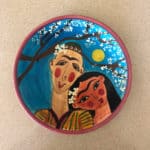In her career as a museum curator, Christina Sumner helped reveal to the world the splendour of Central Asian crafts. Here she retraces her journey as she sought permission to borrow their priceless treasures.
 A small plate with an enchanting hand-painted image of springtime love hangs on my kitchen wall. It catches the light. One of the lovers wears the traditional chapan and doppa (coat and skull cap) of an Uzbek man; above them is a branch laden with almond blossom. The plate was a gift from the director of Tashkent’s Applied Arts Museum, in honour of our excited agreement to collaborate on an exhibition project. It conjures up happy memories of my travels in Central Asia, the warmth of its people and the beauty of its diverse traditional arts.
A small plate with an enchanting hand-painted image of springtime love hangs on my kitchen wall. It catches the light. One of the lovers wears the traditional chapan and doppa (coat and skull cap) of an Uzbek man; above them is a branch laden with almond blossom. The plate was a gift from the director of Tashkent’s Applied Arts Museum, in honour of our excited agreement to collaborate on an exhibition project. It conjures up happy memories of my travels in Central Asia, the warmth of its people and the beauty of its diverse traditional arts.
Plate, Uzbekistan, 2002, hand-painted earthenware, 20 x 2.5 cm. Photo Christina Sumner
This is brief account reflects two decades of professional engagement with Central Asia, and its textiles in particular, and of the luck involved and hurdles encountered when endeavouring to develop a collaborative curatorial project there, soon after the breakup of the Soviet Union. It also tells of the richness and diversity of Central Asian arts as well as some of the kindred spirits I met and the many memorable experiences that affirmed my love affair with the region.
In 1999 I curated an exhibition for the Powerhouse Museum’s recently-established Asian Gallery; titled Beyond the Silk Road: arts of Central Asia, the objects were almost all drawn from the Museum’s own collection. My curiosity about Central Asia and a desire to understand this tantalising and little-known region and its gorgeous crafts had been germinating for a while. I knew the lush nomadic Turkmen and Baluchi rugs and trappings of the region, and proudly owned some modest examples. And in 1992 I had seen an exhibition of suzanis, the beautiful dowry embroideries from urban western Central Asia, here in Sydney. Undoubtedly among the world’s most spectacular traditional textiles, these were an inspiration and the Museum was persuaded to acquire a fine example for the collection.
In Beyond the Silk Road and the catalogue of the same name, we wanted to make sense of the beautifully crafted Central Asian objects in the Museum collection and tell something of the cultures that generated them. The narrative I eventually chose explored the symbiotic relationship between the ethnically distinct nomadic and settled peoples of the Central Asian region, an appreciation of which I felt (and still do) was basic to understanding both the area and its crafts.
You can read the rest of this essay here. If you haven’t subscribed, you can do so here.


